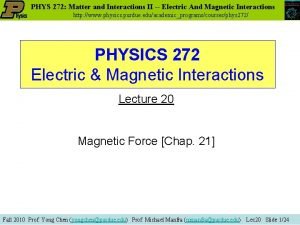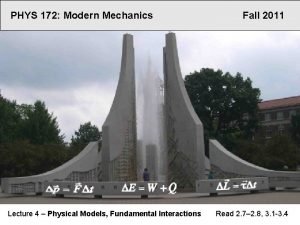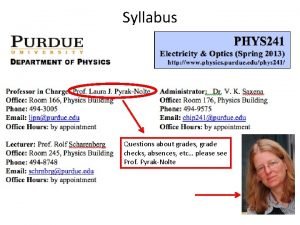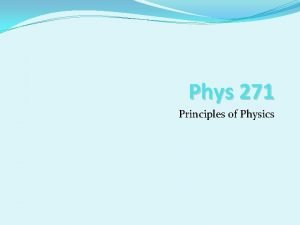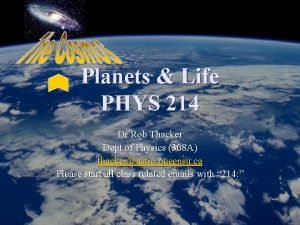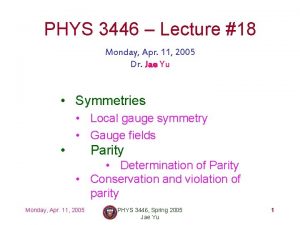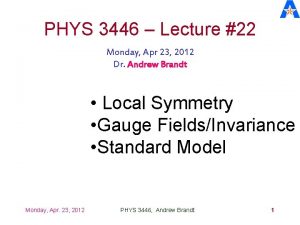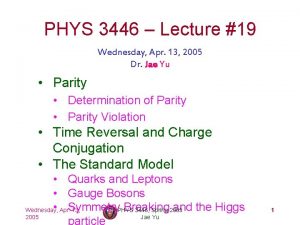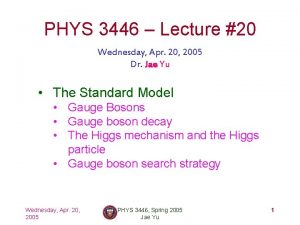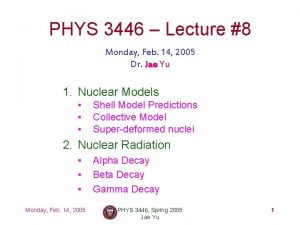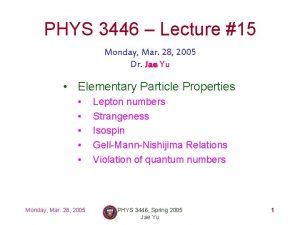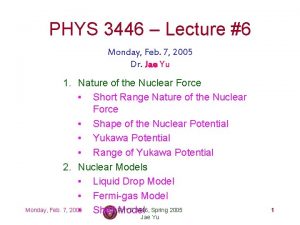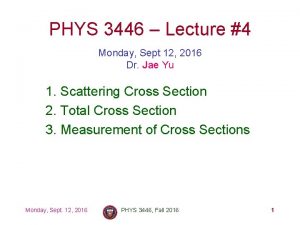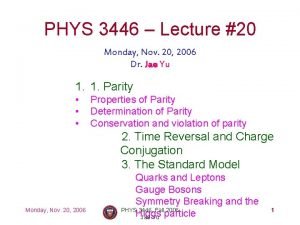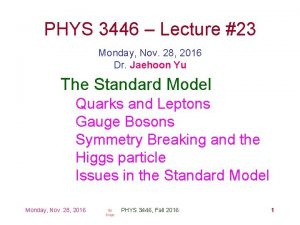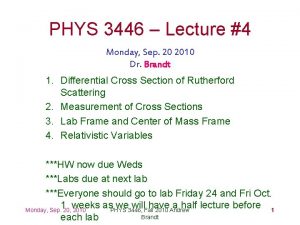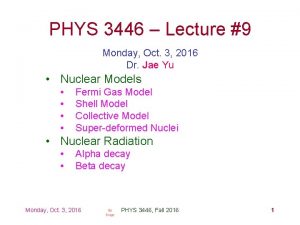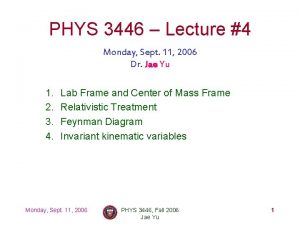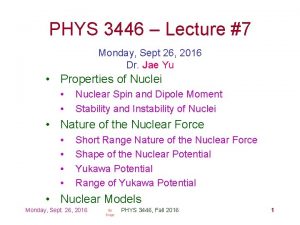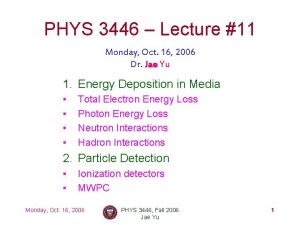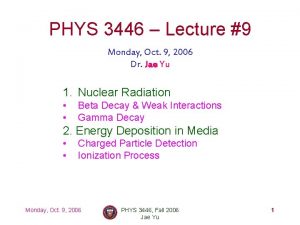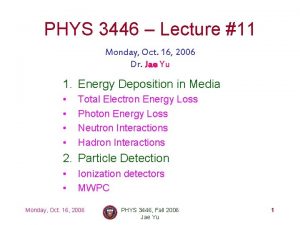PHYS 3446 Lecture 16 Monday Apr 4 2005




















- Slides: 20

PHYS 3446 – Lecture #16 Monday, Apr. 4, 2005 Dr. Jae Yu • Symmetries • • • Monday, Apr. 4, 2005 Why do we care about the symmetry? Symmetry in Lagrangian formalism Symmetries in quantum mechanical system Isospin symmetry Local gauge symmetry PHYS 3446, Spring 2005 Jae Yu 1

Announcements • 3 rd Quiz this Wednesday, Apr. 6 – Covers: Ch. 9 and 10. 5 • Don’t forget that you have another opportunity to do your past due homework at 85% of full if you submit the by Wed. , Apr. 20 • Will have an individual mid-semester discussion this week Monday, Apr. 4, 2005 PHYS 3446, Spring 2005 Jae Yu 2

Quantum Numbers • We’ve learned about various newly introduced quantum numbers as a patch work to explain experimental observations – – Lepton numbers Baryon numbers Isospin Strangeness • Some of these numbers are conserved in certain situation but not in others – Very frustrating indeed…. • These are due to lack of quantitative description by an elegant theory Monday, Apr. 4, 2005 PHYS 3446, Spring 2005 Jae Yu 3

Why symmetry? • Some of the quantum numbers are conserved in strong interactions but not in electromagnetic and weak interactions – Inherent reflection of underlying forces • Understanding conservation or violation of quantum numbers in certain situations is important formulating quantitative theoretical framework Monday, Apr. 4, 2005 PHYS 3446, Spring 2005 Jae Yu 4

Why symmetry? • When does a quantum number conserved? – When there is an underlying symmetry in the system – When the quantum number is not affected (or is conserved) by (under) changes in the physical system • Noether’s theorem: If there is a conserved quantity associated with a physical system, there exists an underlying invariance or symmetry principle responsible for this conservation. Monday, Apr. 4, 2005 PHYS 3446, Spring 2005 5 • Symmetries provide critical restrictions in Jae Yu

• Symmetries in Lagrangian Formalism Symmetry of a system is defined by any set of transformations that keep the equation of motion unchanged or invariant • Equations of motion can be obtained through – Lagrangian formalism: L=T-V where the Equation of motion is what minimizes the lagrangian L under changes of coordinates – Hamiltonian formalism: H=T+V with the equation of motion that minimizes the Hamiltonian under changes of coordinates • Both these formalisms can be used to discuss symmetries in non-relativistic (or classical cases), relativistic, and quantum mechanical Monday, Apr. 4, 2005 PHYS 3446, Spring 2005 6 Jae Yu systems

Symmetries in Lagrangian Formalism? • Consider an isolated non-relativistic physical system of two particles interacting through a potential that only depends on the relative distance between them • The total kinetic and potential energies of the system are: and • The equations of motion are then Monday, Apr. 4, 2005 PHYS 3446, Spring 2005 Jae Yu 7

Symmetries in Lagrangian Formalism • If we perform a linear translation of the origin of coordinate system by a constant vector – The position vectors of the two particles become – But the equation of motions do not change since is a constant vector – This is due to the invariance of the potential V under the translation Monday, Apr. 4, 2005 PHYS 3446, Spring 2005 Jae Yu 8

Symmetries in Lagrangian Formalism • This means that the translation of the coordinate system for an isolated two particle system defines a symmetry of the system (remember Noether’s theorem? ) • This particular physical system is invariant under spatial translation • What is the consequence of this invariance? – From the form of the potential, the total force is – Since Monday, Apr. 4, 2005 Why? PHYS 3446, Spring 2005 Jae Yu 9

Symmetries in Lagrangian Formalism • What does this mean? – Total momentum of the system is invariant under spatial translation • In other words, the translational symmetry results in momentum conservation • This holds for multi-particle, multi-variable system as well!! Monday, Apr. 4, 2005 PHYS 3446, Spring 2005 Jae Yu 10

Symmetries in Lagrangian Formalism • For multi-particle system, using Lagrangian L=T-V the equations of motion can be generalized • By construction, • As previously discussed, for the system with a potential that depends on the relative distance between particles, lagrangian is independent of. Monday, particulars of the individual coordinate Apr. 4, 2005 PHYS 3446, Spring 2005 11 Jae Yu and thus

Symmetries in Lagrangian Formalism • The momentum pi can expanded to other kind of momenta for the given spatial translation – Rotational translation: Angular momentum – Time translation: Energy – Rotation in isospin space: Isospin • The equation says that if the Lagrangian of a physical system does not depend on specifics of a given coordinate, the conjugate momentum are conserved • One can turn this around and state that if a Lagrangian does not depend on some particular coordinate, it must be invariant under translations of this coordinate. Monday, Apr. 4, 2005 PHYS 3446, Spring 2005 Jae Yu 12

Symmetries in Translation and Conserved quantities • The translational symmetries of a physical system dgive invariance in the corresponding physical quantities – Symmetry under linear translation • Linear momentum conservation – Symmetry under spatial rotation • Angular momentum conservation – Symmetry under time translation • Energy conservation – Symmetry under isospin space rotation PHYS 3446, Spring 2005 • Isospin conservation Jae Yu Monday, Apr. 4, 2005 13

Symmetry in Quantum Mechanics • In quantum mechanics, any observable physical quantity corresponds to the expectation value of a Hermitian operator in a given quantum state – The expectation value is given as a product of wave function vectors about the physical quantity (operator) – Wave function ( )is the probability distribution function of a quantum state at any given space-time coordinates Monday, Apr. 4, observable 2005 PHYS Spring 2005 or conserved if 14 – The is 3446, invariant Jae Yu

Continuous Symmetry • All symmetry transformations of a theory can be categorized in – Continuous symmetry: Symmetry under continuous transformation • Spatial translation • Time translation • Rotation – Discrete symmetry: Symmetry under discrete transformation • Transformation in discrete quantum mechanical system Monday, Apr. 4, 2005 PHYS 3446, Spring 2005 Jae Yu 15

Isospin • If there is isospin symmetry, proton (isospin up, I 3= ½) and neutron (isospin down, I 3= -½) are indistinguishable • Lets define a new neutron and proton states as some linear combination of the proton, , and neutron, , wave functions • Then a finite rotation of the vectors in isospin space by an arbitrary angle q about an isospin axis leads to a new set of transformed vectors Monday, Apr. 4, 2005 PHYS 3446, Spring 2005 Jae Yu 16

Isospin • What does the isospin invariance mean to nucleon-nucleon interaction? • Two nucleon quantum state can be written in the following four combinations of quantum states – Proton on proton (I 3=+1) – Neutron on neutron (I 3=-1) – Proton on neutron or neutron on proton for both symmetric or anti-symmetiric (I 3=0) Monday, Apr. 4, 2005 PHYS 3446, Spring 2005 Jae Yu 17

Isospin Tranformation • For I 3=+1 wave function: • For I 3=0 anti-symmetric wave function – This state is totally insensitive to isospin rotation singlet combination of isospins (total isospin 0 PHYS state) Monday, Apr. 4, 2005 3446, Spring 2005 Jae Yu 18

Isospin Tranformation • The other three states corresponds to three possible projection state of the total isospin =1 state (triplet state) • Thus, any two nucleon system can be in a singlet or a triplet state • If there is isospin symmetry in strong interaction all these states are indistinguishable Monday, Apr. 4, 2005 PHYS 3446, Spring 2005 Jae Yu 19

Assignments 1. Construct the Lagrangian for an isolated, two particle system under a potential that depends only on the relative distance between the particles and show that the equations of motion from are 2. Prove that if is a solution for the Schrodinger equation , then is also a solution for it. Apr. 4, for 2005 this is next PHYS 3446, Spring 2005 Apr. 11 20 3. Monday, Due Monday, Jae Yu
 Physics 241
Physics 241 01:640:244 lecture notes - lecture 15: plat, idah, farad
01:640:244 lecture notes - lecture 15: plat, idah, farad Program
Program Sistem za centralizovano prijavljivanje korisnika apr
Sistem za centralizovano prijavljivanje korisnika apr Nominal versus real returns
Nominal versus real returns 21cfr211.180
21cfr211.180 Cours cap apr
Cours cap apr What does apr stand for
What does apr stand for Air purifying respirator (apr)
Air purifying respirator (apr) Jan. feb. mar
Jan. feb. mar Apr vs ear
Apr vs ear àpr
àpr Apr vs ear
Apr vs ear Phys 272 purdue
Phys 272 purdue Iterative prediction of motion
Iterative prediction of motion Physics 102 uiuc
Physics 102 uiuc Purdue phys 241
Purdue phys 241 Mastering physics login
Mastering physics login Single slit envelope
Single slit envelope Tsms phys ed
Tsms phys ed Phys 214
Phys 214













